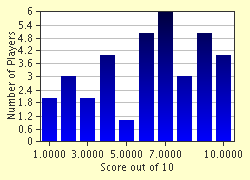Quiz Answer Key and Fun Facts
1. When you pull wool, cotton or silk out of the indigo dyebath, what color does it appear at first? This is the part of indigo dying that seems magical, until you're used to it.
2. What young, female botanist introduced indigo as a cash crop to colonial South Carolina, making it second only to rice? Based on her name, she should have promoted a light red dye rather than blue.
3. You've been waiting: What was the "something gross" that was used in the indigo dying process? Indigo wouldn't dissolve in plain water, but every home and shop had plenty of this sitting around for free, that wasn't being used for anything else.
4. Many plants contain at least a little of the chemical that is indigo dye, but what is the main one, that had the most and was therefore most profitable if you could grow it? Even the genus and species names are based on the Latin words for India, where it was first found, and for a dyer, "tinctor".
5. What kind of work was indigo processing in colonial South Carolina -- hard, easy?
6. Indigo growing spread all over the world, but until natural indigo was replaced with synthetic, one country's dye was considered the best and sold for higher prices than others. What was it?
7. If an inferior dye plant was used to produce indigo dye, what problem could occur? People loved the pure rich blue of indigo, so any variation caused complaint.
8. When Vasco da Gama found a cheap way to reach India by sea in 1498, he caused a drop in the price of indigo, because it no longer needed to go over the old caravan routes. The dye plant woad had been used as a substitute for indigo in England, France and Germany. How did woad growers and dyers react to da Gama's discovery?
9. Let's say you have a certain amount of indigo leaves, a pound, a kilogram, whatever. What weight of wool fiber will that dye, in comparison?
10. The days of natural indigo disappeared when synthetic indigo dye was developed. When did a commercially practical synthetic indigo appear?
Source: Author
littlepup
This quiz was reviewed by FunTrivia editor
looney_tunes before going online.
Any errors found in FunTrivia content are routinely corrected through our feedback system.

